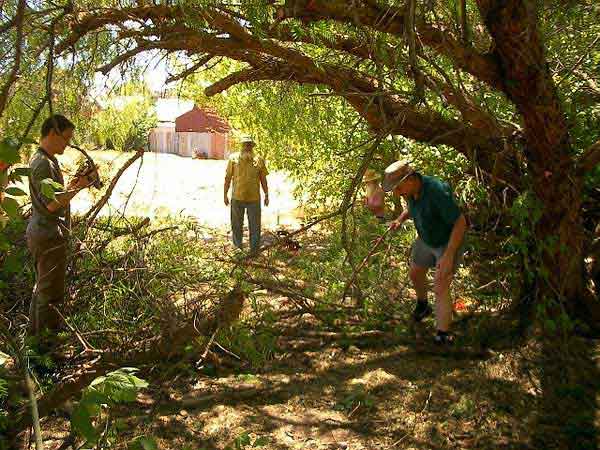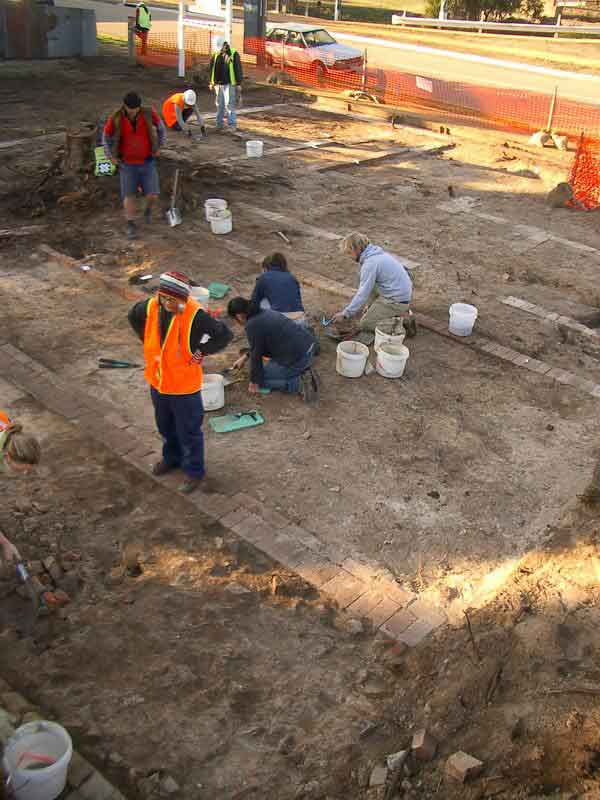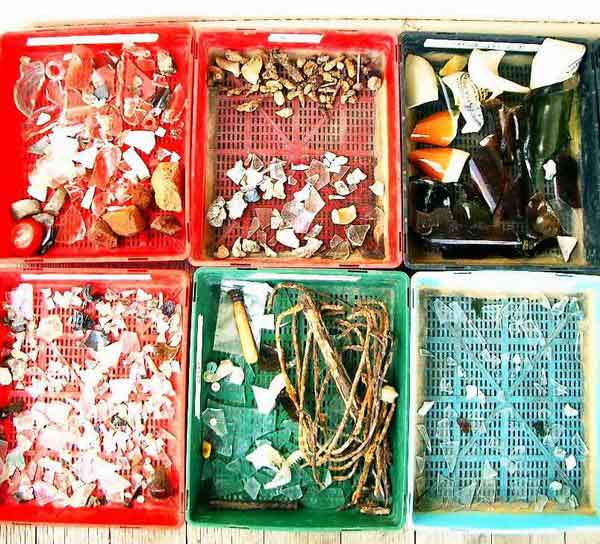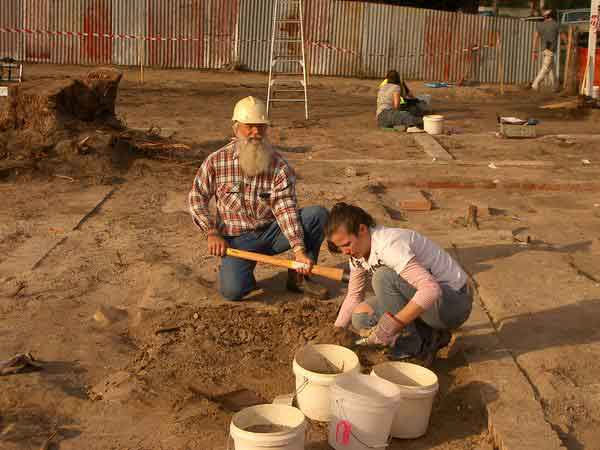| |

|
The siege site of The
Glenrowan Inn as photographed the morning of 28 June 1880
Today below, the hotel site plays a very important historical roll
in the retelling of the siege at
Glen-rowan. Luckily, the land where
the hotel once stood has not been redeveloped largely due to
the conservator owners the Briggs family of Glenrowan.
The Briggs
family purchased the property in 1950 and while two further hotels
were subsequently built
on the site, the second suffered the same
fate as its predecessors, burning down in 1901, and the last
building was demolished in 1977. Linton always had a vision for the
site even though not many cared
too much about the Kelly history in
those early days - till the publishing of contemporary Ned Kelly
pictorial history books, films and documentaries. |
|

|
With great tourist development taking place in Glenrowan, there is a
concerted effort to return the
railway 'siege site' land back to its
former state. This land now has National Heritage Status.
One recent
problem has been to determining the level of improvement for public
amenity verses authenticity in winding the clock back to pre 1880's.
The general consensus is that the siege site should not be a pretty
park with bordered paths, but accurate to its wild rough state as
depicted in
many historic photographs.
Another problem is the relationship between the railway land where
the police mounted their assault
on the Gang, and the Glenrowan Inn
site. The Inn site is pivotal to the authenticity of the whole siege
site which needs to be integrated into one area.
|
|
Below, 11 Nov 2006 the day we cleaned up the Inn site ready for the
Geo scans.

The old Pepper Corn and Desert Ash suckers were given a big trim to
make way for the deep
seeking scanning equipment.
Below, Gary Dean scans
the Glenrowan Inn site using a Caesium Magnetometer, watched on by
Linton Briggs. |
|

|
The deep Goe Magnetic Scan Survey was a pre curser to the
archeological dig for which the
Wangaratta council has funding.
One requirement for the scans was to lay tape for Gary to follow at
one metre increments forming a
grid. Each grid line was measured to
ensure data accuracy.
This grid marking involved the entire
team of
five for
two days. Once the data was in the 'bag' it was sent off to experts
for detail analysis.
Preliminary examination of the Scans show many anomalies
that will be revealed with further
excavations on site. Of
particular interest will be the finding of the original Glenrowan
Inn stump post
holes, a possible cellar and early scans are encouraging.
Images produced by the scans are strong
multi coloured
reminiscent of those seen in thermal heat detection images.
While the scans
are not detecting heat, they are seeing different soil density
compared with un-dug soil. The scans see into
the earth to about 2 metres. Post holes may be seen as yellow, where
as an old pit toilet may be grass green, metal and steel in concrete
as blue with background un dug soil as beige, -
quite remarkable really.
Sorry, but we are un able to show any Geo Scanned images which are
not in a format suitable for
website pages at present.
Bill
3 Jan 2008
As reported on ABC Goulburn Murray radio, 12 Feb 08, - Adam Ford,
director of Dig International will conduct the dig together with
Latrobe University starting in May 2008.
|
|
26 April 2008. Image below :
The block is cleared

Adam Ford started
Saturday 3 May2008 with two colleagues locating and plotting all
major metal objects on the site.
Excavation will start Sunday but
the official opening will take place Monday at 12 noon.
The
project is being launched by Professor Eric Lund, Chair of North
East Victoria Area Consultative Committee. RSVP to Shivaun Brown,
She can be contacted for Group Tours, 11 of which are planned.
s.brown@wangaratta.vic.gov.au or
03 57220776
Volunteer Archaeologist
- Individuals have the opportunity to go on site for a three hour
period and work alongside an archaeologist. This is already over
booked but they will add some extras.
They will work most days for about 4-6 weeks depending on the
weather.
End update, 4 April 2008 Bill
|
|
Background images are of 1/3rd scale replica Kelly gang
armour
Monday 5 May 2008, Professor Eric Lund officially opens the dig.

Steve Hart's helmet
|
Monday 5 May 08
Archeologists prepare the first plot to uncover the more modern
times hotel grog cellar
dug in after the original Ann Jones hotel was burnt down. Whether
there was an earlier cellar
is just one of many things it is hoped to find out from the
excavation..
|
|

Ned
Kelly's helmet
|
Tuesday 6th May 08
Dig project manager Adam Ford gives a talk to school children regarding the
importance of the dig
in preserving our history. In the foreground the you can see
the cellar excavation and the foundation
of the front wall of the third Inn behind it.
|
|

Joe Byrne's helmet
Wednesday 7 May 08.
The removal of concrete pavement from under verandah of the last
hotel built on the site.

Wednesday 7 May 08. With the removal of the concrete we
are now looking at the ground
area of the Ann Jones hotel kitchen.

Ned Kelly's helmet
|
Wednesday 7 May 08. View into cellar
excavation |
|

Thursday 8th May 08.
Archeology is a slow process.
Notice the video camera on tripod- set to capture images in
time-lapse mode..

|
Saturday 10th May 08.
Director Adam Ford oversees the removal of demolition overburden on
the hotel site after test holes reveal that this debris can be
removed safely without damaging the
integrity of the archaeology beneath. It is also done to speed up
the excavation and save a lot of unnecessary hard work. All of this
material will be sieved, however, to locate any artifacts that may
have found their way closer to the surface during the construction
of the three later buildings.
The footings of the last of these, a brick building, will most
likely be left as they are, unless it is
believed that some remains of the Glenrowan Inn may be secreted
beneath them.
Unfortunately the second Inn built on the site by Ann Jones was also
burnt down on the
16th January 1902, and a lot of the ash and debris from both fires
has been mixed together. |
|

Thanks to Kelly historian
Gary Dean for the images and notes.
Following images from
Bill 12 and 13th May
With the mass of overburden removed the footings of the last
building on the site can be seen. |
|

Below,
The cellar bricks down the bottom are hand made while the top half
were machine made.

Each item found is cleaned and sorted according to location, and
this is just the start.


Tuesday13th May 08,
Gary Dean working his patch with a student archaeologist.

|
At this stage the brick footings will probably remain in place with
the ground in between gradually
removed. There maybe as much as 1 foot or more of dirt that needs to
be excavated from in between
the footings before the original ground level is reached.
Sunday 18 May 2008,
Below, In this view the X
indicates where two Martini Henry cartridges were found. To its
right nearer
the little fig tree a number of lead bullets were found on Friday,
they had been flattened from hitting something hard. This is in an
area behind the kitchen of the Inn. The burnt stumps that have been
showing up mostly in the last few days are now believed to be from
the second Inn and not the original, as was first believed. |
|

There is a picture of the Last Stand Hotel Glenrowan circa 1947,
check Google
There is some debate as to whether this was a brick or Weatherboard
building.
Using some image tweaking it is clear the rear section is certainly
wooden boards.
Gary Dean informed me this 3rd Hotel ' last building' was solid Brick
even though there are indications
of sagging board lines under windows sills 3 and 4 from left.
|
|
There is a picture titled
New Jones Hotel circa 1890, check Google as links provided have
changed?
Below, image and note
Gary Dean 22 May 08
In the centre of this view is where the original western chimney
once stood. This will be excavated fully by Monday 26th. As you
can see not much of its location remains, the bricks and footing
having been completely removed, and stump holes have also been
dug into its foundation. The flooring joists can also be seen
here, one on the left of the brick footing. |
|
More to come
For reasons unknown some web browsers leave very large
un-intentional gaps between images.
Please bear with us while we try to
fix this. Use Internet Explorer if things don't look right.
Webpage started 2 Jan 2008
|